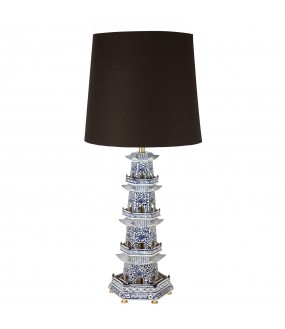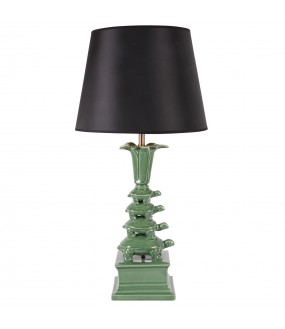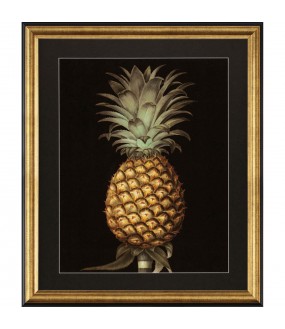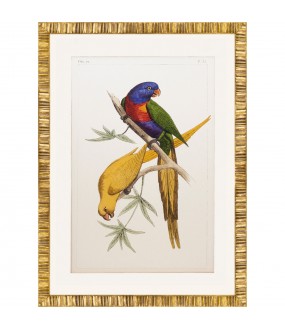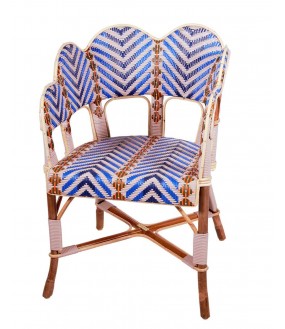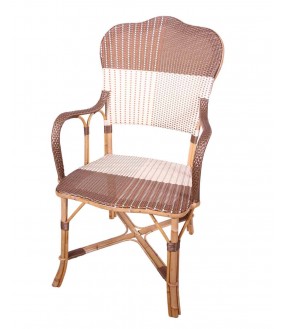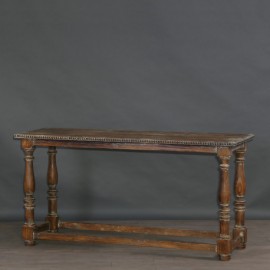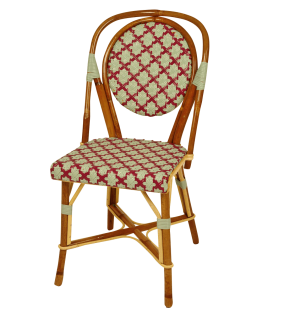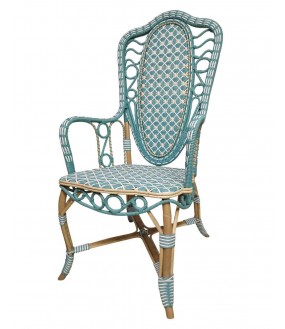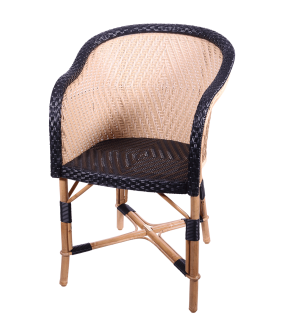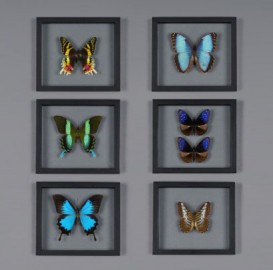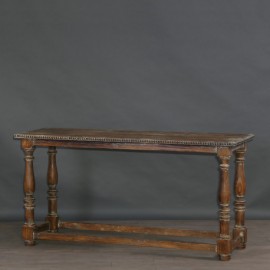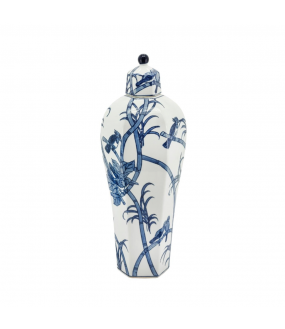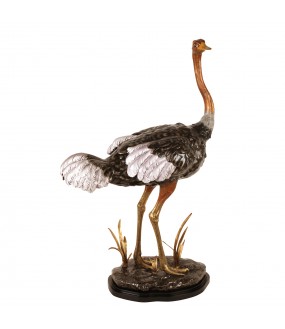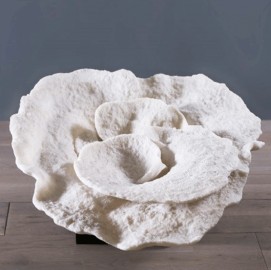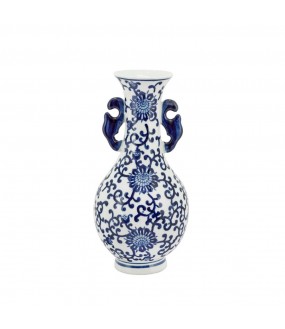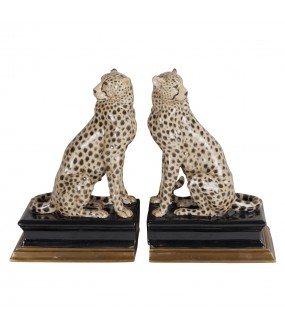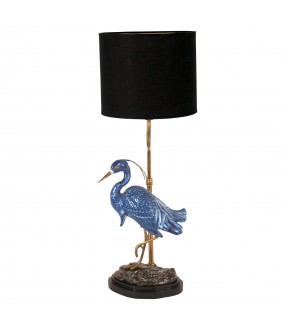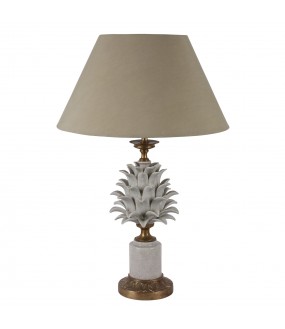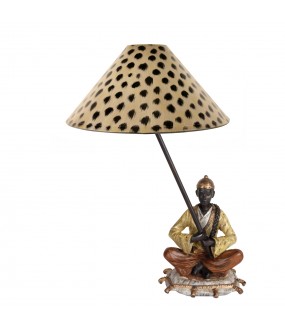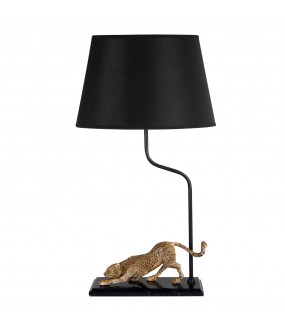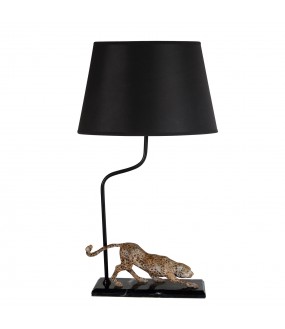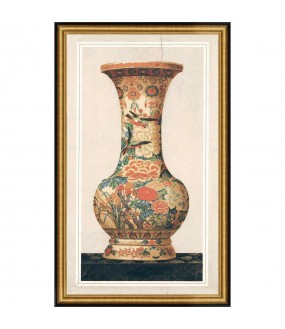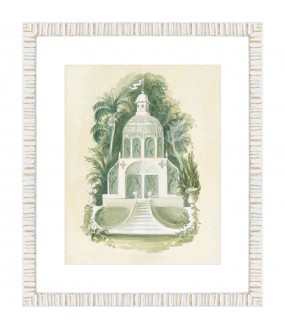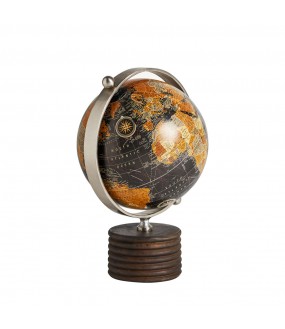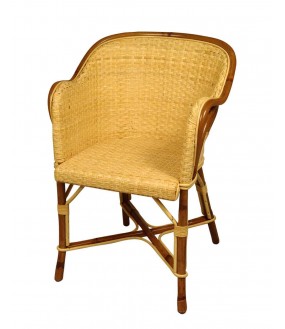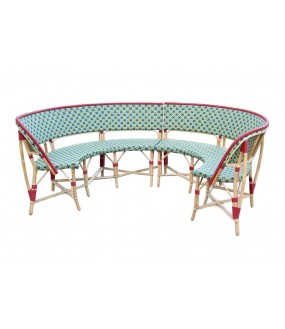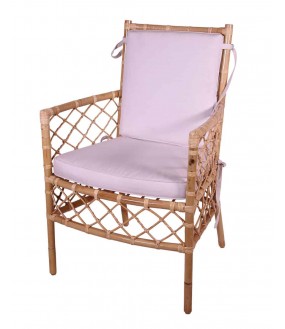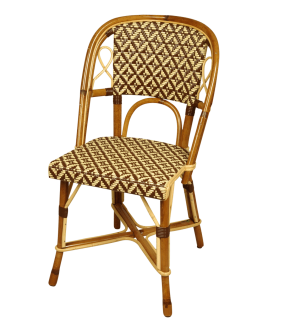STYLES
La Maison Arteslonga likes to explore and bring together styles and eras in a desire for harmony and softness.
Modernist
Minimalist Raw
Luxury Movie Star 50s
Timeless
Orientalist
Baroque
Proustian Era
Greco-Roman
Cabinet of Curiosities
Ethnic Chic
Active filters
- - Style: Carnet de Voyages XIXth
-
Terrestrial globe BERLIN, 1940 Period
€2,388.00Magnificent terrestrial globe, Period 1940 on its cast iron tripod in the shape of a lion's paw and with human faces presence. Large terrestrial globe 45 cm in diameter and 88cm in height. in pastel tones. An authentic old piece signed
COLUMBUS ERDGLOBUS - BERLIN
. A very beautiful object of decoration and collection.
-
Table Lamp Banana Tree H84cm
€1,080.00Stand out from the crowd with the Banana Tree Table Lamp. This brilliant piece of design features shades in the form of three banana leaves arms with a vintage brass finish. Resting on a round black granite base, this botanical style table lamp is perfect for adding a designer look to contemporary and eclectic interiors.
-
Hexagonal Pagoda Table Lamp
€1,388.01Hexagonal Pagoda lamp made of porcelain with its bronze feet All details are hand painted. Very beautiful handcrafted decorative object of great delicacy. An entirely handcrafted decorative object. Lamp dimensions: H: 71 cm | ø: 28 cm Delivered without lampshade.
-
Turtle Tower Lamp
€702.00Turtle Tower lamp made of enamelled porcelain in Jade green color. All details are hand painted. Very beautiful handcrafted decorative object of great delicacy. An entirely handcrafted decorative object made in Italy. Lamp dimensions: H: 55 cm | W: 18 cm | D: 18 cm. Delivered with its shade. Magnificent.
-
Parrots Engravings Lemaire, Set of 4
€620.00A set of four beautiful reproductions of engravings of Amazon parrots and parakeets from Lemaire dating from the end of the 19th century.
Golden ornamentation frame.
Each engraving: H50cm by 40cm wide
-
Rattan Armchair Gabrielle, Made On Order
€1,780.00The Gabrielle chair. Superb handcrafted armchair in woven rattan.
Manufacturing on demand.
Welcoming with its fully woven backrest and its generous shapes, the Gabrielle armchair is an armchair for restaurants, bistros, cafés, gardens or dining rooms in woven rattan in the colors of your desires, non-stackable and is as beautiful inside as it is outside.
Very comfortable, the Gabrielle armchair is light and very resistant.
This armchair will beautify your living room, your kitchen, your terrace, your veranda or your restaurant.
A magnificent French craftsmanship, the Gabrielle armchair is entirely handmade.
Type: chair with wide seat 43cm
Stackability: Not stackable
Indoor/Outdoor: Semi-Outdoor
Fiber: Satin (Raucord)
Colours: Satin Beige – Pantone 7502, Satin Ultramarine Blue – Pantone 534, Satin Royal Blue, Satin Terracotta, Satin Olive Green – Pantone 5743
Structure materials: Dark rattan (Malacca)
Weaving range: exceptions
Colours: Satin Beige – Pantone 7502, Satin Ultramarine Blue – Pantone 534, Satin Royal Blue, Satin Terracotta, Satin Olive Green – Pantone 5743
Seat height: 45cm
Seat width: Wide seat (43 cm).
Overall height: 81cm
Overall width: 58cm
Overall depth: 63cm
Weight: 7kg
Varnish and paint: Varnish
Rattan, a material with extraordinary properties with limits.
Rattan is a vine of the Palm race, which grows in very humid or even swampy equatorial forests.
With its siliceous skin like glass, this extremely solid and light vine is particularly resistant to humidity, as are tropical woods, teak or others.
But this resistance has its limits. Exposed to rain, rattan resists very well for a whole day or even a few days. But if this rain continues for too many hours, the humidity will gradually penetrate the Rattan, and day after day the material kept damp will end up slowly degrading and losing its resistance qualities.
The physical limits of rattan imply precautions for use. On the terraces of Parisian cafes, the chairs can last for decades while they are often in the rain all day for long periods. But they are piled up every night under cover and can thus dry out.
More generally, rattan can withstand rain for long hours without compromising its longevity, but must be able to dry regularly.
In practice, rattan furniture can stay outside throughout the "summer season", the weather is hot and rather dry, continuous rains exceptionally last more than three or four days and Rattan withstands such rains without degrading.
But as soon as the season advances, the temperature drops, there is a lot of condensation and humidity, the Rattan will gradually become humid, the long and heavy rains accentuating this degradation. In practice, these are sensitive situations by the sea.
It is then imperative to put the seats under shelter, a ventilated shelter to avoid progressive humidification as soon as the "bad season" arrives, in practice from mid-October to mid-March for a continental climate.
The alternative if you want to use your Rattan furniture all year round, is to put it away daily, every evening, as Parisian terraces do.
In summary, 2 main principles to respect:
During the winter season (October 15 to March 15 in Europe) in all climates: the furniture must be stored “dry”. It can however be left outside during the day, but must imperatively be put in the dry during the night.
During the "beautiful season", the rest of the time, the Rattan can remain permanently outside.
However, if a lasting rain arrives, the Rattan should only be left in this rain for two or three days at the most, before putting the furniture in the dry place so that it can dry. He only takes it out once the rain has stopped (In any case, a terrace cannot be used in the rain).
En savoir plus sur ce texte sourceVous devez indiquer le texte source pour obtenir des informations supplémentaires
Envoyer des commentaires
Panneaux latéraux
-
Large Cane Rattan Armchair, Made On Order
€1,360.00Superb handcrafted armchair in woven rattan.
This cane rattan armchair with natural slat underlined with tinted slat naturally finds its place as a garden armchair, living room armchair in town, veranda armchair facing the sea.
This chair must be protected from the rain.
Manufacturing on demand.
Welcoming with its fully woven backrest and its generous shapes, this armchair is a restaurant armchair, in the colors of your desires, non-stackable, and is as beautiful inside as it is outside.
Very comfortable, this cane rattan armchair is light and very resistant.
A magnificent French craftsmanship, this armchair is entirely handmade.
Type: chair with wide seat 43cm
Stackability: Not stackable
Indoor/Outdoor: Semi-Outdoor
Fiber: Satin (Raucord)
Colours: Satin Chocolate – Pantone 476, Satin Ivory – Pantone 7506, Satin Terracotta
Structure materials: Light rattan (Manila)
Weaving range: Classic
Seat height: 45cm
Seat width: Wide seat (43 cm).
Overall height: 102cm
Overall width: 61cm
Overall depth: 63cm
Weight: 7kg
Varnish and paint: Varnish
Rattan, a material with extraordinary properties with limits.
Rattan is a vine of the Palm race, which grows in very humid or even swampy equatorial forests.
With its siliceous skin like glass, this extremely solid and light vine is particularly resistant to humidity, as are tropical woods, teak or others.
But this resistance has its limits. Exposed to rain, rattan resists very well for a whole day or even a few days. But if this rain continues for too many hours, the humidity will gradually penetrate the Rattan, and day after day the material kept damp will end up slowly degrading and losing its resistance qualities.
The physical limits of rattan imply precautions for use. On the terraces of Parisian cafes, the chairs can last for decades while they are often in the rain all day for long periods. But they are piled up every night under cover and can thus dry out.
More generally, rattan can withstand rain for long hours without compromising its longevity, but must be able to dry regularly.
In practice, rattan furniture can stay outside throughout the "summer season", the weather is hot and rather dry, continuous rains exceptionally last more than three or four days and Rattan withstands such rains without degrading.
But as soon as the season advances, the temperature drops, there is a lot of condensation and humidity, the Rattan will gradually become humid, the long and heavy rains accentuating this degradation. In practice, these are sensitive situations by the sea.
It is then imperative to put the seats under shelter, a ventilated shelter to avoid progressive humidification as soon as the "bad season" arrives, in practice from mid-October to mid-March for a continental climate.
The alternative if you want to use your Rattan furniture all year round, is to put it away daily, every evening, as Parisian terraces do.
In summary, 2 main principles to respect:
During the winter season (October 15 to March 15 in Europe) in all climates: the furniture must be stored “dry”. It can however be left outside during the day, but must imperatively be put in the dry during the night.
During the "beautiful season", the rest of the time, the Rattan can remain permanently outside.
However, if a lasting rain arrives, the Rattan should only be left in this rain for two or three days at the most, before putting the furniture in the dry place so that it can dry. He only takes it out once the rain has stopped (In any case, a terrace cannot be used in the rain).
En savoir plus sur ce texte sourceVous devez indiquer le texte source pour obtenir des informations supplémentaires
Envoyer des commentaires
Panneaux latéraux
-
18th Century Italian Baluster Console
€2,280.00Reissue of an 18th century Italian baluster console. Its shapes are typical of the Tuscany region. It is adorned with upholstery nails around the top, reminding us of the original existence of a velvet-covered top. Handcrafted in old aged pine and old-fashioned patina made by hand.
-
Rattan Armchair 1900s Vintage Style
€1,200.00Imposing vintage 1900 style armchair but light (7kg), "tailor-made" woven in synthetic fiber.
Price upon request.
This synthetic fiber armchair can be left outside friends in order to preserve the quality of the rattan furniture, it is imperative to store it in a dry place during the winter season. It does not support prolonged bad weather and/or high permanent humidity.
This large rattan armchair will embellish your kitchen, your living room, your terrace, your veranda or your restaurant.
Overall height: 80cm
Overall width: 64cm
Overall depth: 62cm
Weight: 7kg
Seat height: 45cm
Seat width: 43 cm wide seat
Indoor/Outdoor: Semi-Outdoor
Stackability: Not stackable
Material: dark rattan
Weaving fiber: Brilliant (Rilsan)
Colour: Brilliant Red – Pantone 1807, Brilliant Old Rose – Pantone 7522
Finish: Varnish
The Cruise Line armchair is also presented here in natural rattan fibre.
Rattan, a material with extraordinary properties with limits. Rattan is a vine of the Palm race, which grows in very humid or even swampy equatorial forests.
With its siliceous skin like glass, this extremely solid and light vine is particularly resistant to humidity, as are tropical woods, teak or others.
But this resistance has its limits. Exposed to rain, rattan resists very well for a whole day or even a few days. But if this rain continues for too many hours, the humidity will gradually penetrate the Rattan, and day after day the material kept damp will end up slowly degrading and losing its resistance qualities.
The physical limits of rattan imply precautions for use. On the terraces of Parisian cafes, the chairs can last for decades while they are often in the rain all day for long periods. But they are piled up every night under cover and can thus dry out.
More generally, rattan can withstand rain for long hours without compromising its longevity, but must be able to dry regularly.
In practice, rattan furniture can stay outside throughout the "summer season", the weather is hot and rather dry, continuous rains exceptionally last more than three or four days and Rattan withstands such rains without degrading.
But as soon as the season advances, the temperature drops, there is a lot of condensation and humidity, the Rattan will gradually become humid, the long and heavy rains accentuating this degradation. In practice, these are sensitive situations by the sea.
It is then imperative to put the seats under shelter, a ventilated shelter to avoid progressive humidification as soon as the "bad season" arrives, in practice from mid-October to mid-March for a continental climate.
The alternative if you want to use your Rattan furniture all year round, is to put it away daily, every evening, as Parisian terraces do.
In summary, 2 main principles to respect:
During the winter season (October 15 to March 15 in Europe) in all climates: the furniture must be stored “dry”. It can however be left outside during the day, but must imperatively be put in the dry during the night.
During the "beautiful season", the rest of the time, the Rattan can remain permanently outside.
However, if a lasting rain arrives, the Rattan should only be left in this rain for two or three days at the most, before drying the furniture to
so that it can dry out. He only takes it out once the rain has stopped (In any case, a terrace cannot be used in the rain).
En savoir plus sur ce texte sourceVous devez indiquer le texte source pour obtenir des informations supplémentaires
Envoyer des commentaires
Panneaux latéraux
-
Rattan Medallion Chair, Made on Demand
€1,128.00The rattan medallion chair. Superb handcrafted rattan chair, made on demand.
Price upon request.
This cane chair is ideal for your terrace, in your garden but also for your interior.
Very comfortable, the Anatole chair is light and very resistant.
This chair will beautify your living room, your kitchen, your terrace, your veranda or your restaurant.
A magnificent French craftsmanship, the Anatole chair is entirely handmade.
Type: chair with wide seat 43cm
Stackability: stackable
Indoor/Outdoor: Semi-outdoor
Fiber: Brilliant (Rilsan)
Colours: Gloss Bordeaux, Gloss Yellow, Gloss Putty
Structure materials: Dark rattan (Malacca)
Weaving range: prestige
Colours: Brilliant Burgundy – Pantone 188, Jade Green – Pantone 556, Brilliant Mint Green – Pantone 5787
Seat height: 45cm
Overall height: 87cm
Overall width: 50cm
Overall depth: 45cm
Weight: 5kg
Varnish and paint: Varnish
Rattan, a material with extraordinary properties with limits.
Rattan is a vine of the Palm race, which grows in very humid or even swampy equatorial forests.
With its siliceous skin like glass, this extremely solid and light vine is particularly resistant to humidity, as are tropical woods, teak or others.
But this resistance has its limits. Exposed to rain, rattan resists very well for a whole day or even a few days. But if this rain continues for too many hours, the humidity will gradually penetrate the Rattan, and day after day the material kept damp will end up slowly degrading and losing its resistance qualities.
The physical limits of rattan imply precautions for use. On the terraces of Parisian cafes, the chairs can last for decades while they are often in the rain all day for long periods. But they are piled up every night under cover and can thus dry out.
More generally, rattan can withstand rain for long hours without compromising its longevity, but must be able to dry regularly.
In practice, rattan furniture can stay outside throughout the "summer season", the weather is hot and rather dry, continuous rains exceptionally last more than three or four days and Rattan withstands such rains without degrading.
But as soon as the season advances, the temperature drops, there is a lot of condensation and humidity, the Rattan will gradually become humid, the long and heavy rains accentuating this degradation. In practice, these are sensitive situations by the sea.
It is then imperative to put the seats under shelter, a ventilated shelter to avoid progressive humidification as soon as the "bad season" arrives, in practice from mid-October to mid-March for a continental climate.
The alternative if you want to use your Rattan furniture all year round, is to put it away daily, every evening, as Parisian terraces do.
In summary, 2 main principles to respect:
During the winter season (October 15 to March 15 in Europe) in all climates: the furniture must be stored “dry”. It can however be left outside during the day, but must imperatively be put in the dry during the night.
During the "beautiful season", the rest of the time, the Rattan can remain permanently outside.
However, if a lasting rain arrives, the Rattan should only be left in this rain for two or three days at the most, before putting the furniture in the dry place so that it can dry. He only takes it out once the rain has stopped (In any case, a terrace cannot be used in the rain).
En savoir plus sur ce texte sourceVous devez indiquer le texte source pour obtenir des informations supplémentaires
Envoyer des commentaires
Panneaux latéraux
-
Rattan Armchair Sophia 1920's, Made On Order
€2,520.00The Sophia armchair from the 1920s. Superb handcrafted armchair in woven rattan.
Manufacturing on demand.
Welcoming with its fully woven high backrest and generous shapes, the Sophia armchair is an armchair for a restaurant, bistro, café, garden or dining room in woven rattan in the colors of your desires, non-stackable, is as beautiful inside as it is outside .
Very comfortable, the Sophia armchair is light and very resistant.
This armchair will beautify your living room, your kitchen, your terrace, your veranda or your restaurant.
A magnificent French craftsmanship, the Sophia armchair is entirely handmade.
Type: chair with wide seat 43cm
Stackability: Not stackable
Indoor/Outdoor: Semi-Outdoor
Fiber: Satin (Raucord)
Colours: Satin White, Satin Soft Blue – Pantone 5493, Satin Ivory – Pantone 7506
Structure materials: Light rattan (Manila)
Weaving range: masterpiece.
Seat height: 45cm
Seat width: Wide seat (43 cm).
Overall height: 120cm
Overall width: 62cm
Overall depth: 72cm
Weight: 7kg
Varnish and paint: Unvarnished
Rattan, a material with extraordinary properties with limits.
Rattan is a vine of the Palm race, which grows in very humid or even swampy equatorial forests.
With its siliceous skin like glass, this extremely solid and light vine is particularly resistant to humidity, as are tropical woods, teak or others.
But this resistance has its limits. Exposed to rain, rattan resists very well for a whole day or even a few days. But if this rain continues for too many hours, the humidity will gradually penetrate the Rattan, and day after day the material kept damp will end up slowly degrading and losing its resistance qualities.
The physical limits of rattan imply precautions for use. On the terraces of Parisian cafes, the chairs can last for decades while they are often in the rain all day for long periods. But they are piled up every night under cover and can thus dry out.
More generally, rattan can withstand rain for long hours without compromising its longevity, but must be able to dry regularly.
In practice, rattan furniture can stay outside throughout the "summer season", the weather is hot and rather dry, continuous rains exceptionally last more than three or four days and Rattan withstands such rains without degrading.
But as soon as the season advances, the temperature drops, there is a lot of condensation and humidity, the Rattan will gradually become humid, the long and heavy rains accentuating this degradation. In practice, these are sensitive situations by the sea.
It is then imperative to put the seats under shelter, a ventilated shelter to avoid progressive humidification as soon as the "bad season" arrives, in practice from mid-October to mid-March for a continental climate.
The alternative if you want to use your Rattan furniture all year round, is to put it away daily, every evening, as Parisian terraces do.
In summary, 2 main principles to respect:
During the winter season (October 15 to March 15 in Europe) in all climates: the furniture must be stored “dry”. It can however be left outside during the day, but must imperatively be put in the dry during the night.
During the "beautiful season", the rest of the time, the Rattan can remain permanently outside.
However, if a lasting rain arrives, the Rattan should only be left in this rain for two or three days at the most, before putting the furniture in the dry place so that it can dry. He only takes it out once the rain has stopped (In any case, a terrace cannot be used in the rain).
-
Beige Rattan Armchair, Vintage Style
€900.00Imposing vintage 1900 style armchair but light (7kg), entirely woven with natural blade, it can be woven "to measure" in synthetic fiber.
Available from stock.
This natural fiber armchair must be protected from the rain.
This large rattan armchair will embellish your kitchen, your living room, your terrace, your veranda or your restaurant.
Overall height: 78cm
Overall width: 75cm
Overall depth: 53cm
Weight: 7kg
Seat height: 45cm
Height of the armrests: 72 cm
Seat width: 43 cm wide seat
Indoor/Outdoor: Semi-Outdoor
Colours: Satin beige – Pantone 7502, Satin black – Pantone Black C
Stackability: Not stackable
Weaving fibers: Satin (Raucord)
Finish: Varnish
Structure materials: Light rattan (Manila)
Rattan is a material with extraordinary properties with limits. Rattan is a vine of the Palm race, which grows in very humid or even swampy equatorial forests.
With its siliceous skin like glass, this extremely solid and light vine is particularly resistant to humidity, as are tropical woods, teak or others.
But this resistance has its limits. Exposed to rain, rattan resists very well for a whole day or even a few days. But if this rain continues for too many hours, the humidity will gradually penetrate the Rattan, and day after day the material kept damp will end up slowly degrading and losing its resistance qualities.
The physical limits of rattan imply precautions for use. On the terraces of Parisian cafes, the chairs can last for decades while they are often in the rain all day for long periods. But they are piled up every night under cover and can thus dry out.
More generally, rattan can withstand rain for long hours without compromising its longevity, but must be able to dry regularly.
In practice, rattan furniture can stay outside throughout the "summer season", the weather is hot and rather dry, continuous rains exceptionally last more than three or four days and Rattan withstands such rains without degrading.
But as soon as the season advances, the temperature drops, there is a lot of condensation and humidity, the Rattan will gradually become humid, the long and heavy rains accentuating this degradation. In practice, these are sensitive situations by the sea.
It is then imperative to put the seats under shelter, a ventilated shelter to avoid progressive humidification as soon as the "bad season" arrives, in practice from mid-October to mid-March for a continental climate.
The alternative if you want to use your Rattan furniture all year round, is to put it away daily, every evening, as Parisian terraces do.
In summary, 2 main principles to respect:
During the winter season (October 15 to March 15 in Europe) in all climates: the furniture must be stored “dry”. It can however be left outside during the day, but must imperatively be put in the dry during the night.
During the "beautiful season", the rest of the time, the Rattan can remain permanently outside.
However, if a lasting rain arrives, the Rattan should only be left in this rain for two or three days at the most, before putting the furniture in the dry place so that it can dry. He only takes it out once the rain has stopped (In any case, a terrace cannot be used in the rain).
-
6 Papillons - Série
€500.01 -
Engravings Japanese Vases
€850.00Two beautiful engravings of silhouettes of hand-printed Japanese Vases. Framing and engravings entirely realized and designed in Italy. These exquisite engravings are engraved and printed on antique presses from the 1800s. Each image is printed by hand, piece by piece.
-
Bespoke 18th Century Italian Baluster Console
Reissue of an 18th century Italian baluster console. Its shapes are typical of the Tuscany region. It is adorned with upholstery nails around the top, reminding us of the original existence of a velvet-covered top. Handcrafted in old aged pine and old-fashioned patina made by hand.
-
Wild Bamboo Porcelain Jar H53cm
€290.01This decorative white glazed ceramic jar decorated with beautiful blue drawings of wild bamboos and birds in the oriental style.
Entirely hand-painted, this contemporary enameled white porcelain jar is inspired by ancient Chinese ceramics.
Completely hand painted.
Italian craftsmanship.
A limited edition.
Height of this jar: 53 cm
-
Porcelain and Brass Ostrich H76cm
€2,280.00Superb ostrich figurine made of enamelled porcelain and brass with a total height of 76cm.
A current craft work of great beauty.
The legs of the bird and the plants are made of brass.
A remarkable piece for a refined and unique interior decoration.
-
Palm Tree Engravings, Italy - h130cm
€2,350.00Wonderful engravings of hand-printed Palm trees. Framing and engravings entirely realized and designed in Florence, Italy. These exquisite engravings are engraved and printed on antique presses from the 1800s. Each image is printed by hand, piece by piece.
-
Montipora Coral, CITES certified
€924.00This Montipora coral has a shape typical of its species: it looks like a flower. This coral has grown sheltered from strong waves, and underwater, only the border of these delicate petals is bright pink. This Pacific coral is accompanied by its CITES certificate, since it is, of course, perfectly legal.
-
Pair of Red Travertine Trays ø21cm
€320.00Two round trays in red travertine, natural stone.
21cm diameter
Craftsmanship
Weight: 0.8 kg each
-
Coral Montipora - Reproduction
€430.00Reproduction of a coral "montipora" of the lagoons of oceania. Coral is indeed an animal of the branch of the Cnidarians. Corals generally live in colonies of individuals called "polyps" which are "superorganisms". Each polyp secretes its own exoskeleton; Depending on the species, this exoskeleton is hard or soft.
-
Chinese Porcelain Vase with Handles H36cm
€120.00Chinoiserie vase in white ceramic with double handles with blue oriental floral motifs.
Completely hand painted.
Homemade.
A limited edition.
Vase height: 36 cm
-
Pair of Porcelain Bookends Cheetas
€960.00A pair of porcelain bookends.
Unusual decorative objects, two pretty hand-painted porcelain cheetas to decorate the shelves of your library.
Base made of black ceramic and base in bronze-colored brass.
A beautiful handcrafted achievement.
-
Porcelain & Bronze Blue Heron Table Lamp
€1,092.00Heron sculpture made in porcelain with its bronze paste and details mounted as a table lamp. All details are hand painted. Very beautiful handcrafted decorative object of great delicacy. An entirely handcrafted decorative object made in Italy. Magnificent.
-
Porcelain & Bronze Blue Heron Table Lamp
€842.01Heron sculpture made in porcelain with its bronze paste and details mounted as a table lamp. All details are hand painted. Very beautiful handcrafted decorative object of great delicacy. An entirely handcrafted decorative object made in Italy. Magnificent.
-
Pineapple Table Lamp in Porcelain, H44cm
€767.01Large white porcelain pineapple lamp with a height of 44cm (without the lampshade)
Pineapple column in worked porcelain and base of the foot in sculpted bronze, 44cm high and 13cm in diameter.
Lamp sold without the lampshade.
Golden electric wire.
A lamp of great finesse and elegance.
A very beautiful decorative object for a charming interior.
A remarkable piece for a refined and unique interior decoration.
-
Table Lamp Chinese Man - Left
€1,080.00Table lamp - Chinese figurine man sitting in the lotus position.
The figurine is made of brass and hand painted.
Handpainted cracked cardboard shade, hand painted in brown and golden borders.
-
Table Lamp Chinese Woman - Left
€1,080.00 -
Cheetah table lamp - Left
€988.00 -
Cheetah Table Lamp - Right
€988.00Cheetah table lamp figurine made in brass and marble base.
Oval Cheetah pattern shade.
-
Ancient Chinese Vases Engravings , Set of 2, H70cm
€650.01Set of 2 very beautiful reproductions of engravings of ancient Chinese vases. Each print is surrounded by an elegant distressed wood frame and clear glass.
-
Reproduction of watercolors, Architecture and...
€610.00Reproduction of watercolors, Architecture and Botany of distant lands. Set of 2 very beautiful reproductions of watercolors.
Each print is surrounded by an elegant white wood frame with light aged effect gold inlays and clear glass.
Dimensions of each engraving: H60 x 50cm.
Elegance assured.
-
Earth Globe H42cm
€260.00A large earth globe in soft tones of pink and pale green. On a black wooden cross base. 12 inches globe.Black and bronze terrestrial globe in vintage style on its mango wood stand.
Size of the globe: 32 cm in diameter and total height 43cm.
The base is made of turned solid mango wood in coffee color.
Crazy elegance.
A craftsmanship full of finesse and delicacy.
-
Earth Globe H34cm
€180.00A large earth globe in soft tones of pink and pale green. On a black wooden cross base. 12 inches globe.Black and bronze terrestrial globe in vintage style on its mango wood stand.
Size of the globe: 21cm in diameter and total height 34cm.
The base is made of turned solid mango wood in coffee color.
Crazy elegance.
A craftsmanship full of finesse and delicacy.
-
Large Rattan Armchair Vintage Style 1900's
€800.00Imposing armchair in vintage style but light, entirely woven with natural lamina, it can be woven "to measure" in synthetic fibre.
Available from stock, price on request.
This natural fiber armchair.
This large rattan armchair will embellish your kitchen, your living room, your terrace, your veranda or your restaurant.
Overall height: 80cm
Overall width: 64cm
Overall depth: 62cm
Weight: 7kg
Seat height: 45cm
Seat width: 43 cm wide seat
Indoor/Outdoor: Indoor (this furniture must absolutely remain dry.)
Colors: Cannage Natural blade
Stackability: Not stackable
Material: Light Rattan (Manila)
Fiber: Natural Blade
Finish: Glossy varnish
Possibility of weaving the Cruise line armchair in your colors, a made-to-measure production with the color of caning and the weaving of your choice (see photos).
Rattan, a material with extraordinary properties with limits. Rattan is a vine of the Palm race, which grows in very humid or even swampy equatorial forests.
With its siliceous skin like glass, this extremely solid and light vine is particularly resistant to humidity, as are tropical woods, teak or others.
But this resistance has its limits. Exposed to rain, rattan resists very well for a whole day or even a few days. But if this rain continues for too many hours, the humidity will gradually penetrate the Rattan, and day after day the material kept damp will end up slowly degrading and losing its resistance qualities.
The physical limits of rattan imply precautions for use. On the terraces of Parisian cafes, the chairs can last for decades while they are often in the rain all day for long periods. But they are piled up every night under cover and can thus dry out.
More generally, rattan can withstand rain for long hours without compromising its longevity, but must be able to dry regularly.
In practice, rattan furniture can stay outside throughout the "summer season", the weather is hot and rather dry, continuous rains exceptionally last more than three or four days and Rattan withstands such rains without degrading.
But as soon as the season advances, the temperature drops, there is a lot of condensation and humidity, the Rattan will gradually become humid, the long and heavy rains accentuating this degradation. In practice, these are sensitive situations by the sea.
It is then imperative to put the seats under shelter, a ventilated shelter to avoid progressive humidification as soon as the "bad season" arrives, in practice from mid-October to mid-March for a continental climate.
The alternative if you want to use your Rattan furniture all year round, is to put it away daily, every evening, as Parisian terraces do.
In summary, 2 main principles to respect:
During the winter season (October 15 to March 15 in Europe) in all climates: the furniture must be stored “dry”. It can however be left outside during the day, but must imperatively be put in the dry during the night.
During the "beautiful season", the rest of the time, the Rattan can remain permanently outside.
However, if a lasting rain arrives, the Rattan should only be left in this rain for two or three days at the most, before drying the furniture to
so that it can dry out. He only takes it out once the rain has stopped (In any case, a terrace cannot be used in the rain).
-
Magnificent Rattan Chair, Made on Order
€1,398.00Superb handcrafted rattan chair, made on demand.
This cane chair is ideal for your terrace, in your garden but also for your interior.
Very comfortable, this exceptional rattan chair is light and very resistant.
This chair will beautify your living room, your kitchen, your terrace, your veranda or your restaurant.
A magnificent French craftsmanship, this chair is entirely handmade.
Type: chair with wide seat 43cm
Stackability: Not stackable
Indoor/Outdoor: Indoor, Outdoor friendly
Fiber: Satin (Raucord)
Structure materials: Dark rattan (Malacca)
Weaving range: exceptions
Colours: Satin Beige – Pantone 7502, Satin Ultramarine Blue – Pantone 534, Satin Royal Blue, Satin Terracotta, Satin Olive Green – Pantone 5743
Seat height: 45cm
Seat width: Wide seat
Overall height: 81cm
Overall width: 58cm
Overall depth: 63cm
Weight: 7kg
Varnish and paint: Varnish
Rattan, a material with extraordinary properties with limits.
Rattan is a vine of the Palm race, which grows in very humid or even swampy equatorial forests.
With its siliceous skin like glass, this extremely solid and light vine is particularly resistant to humidity, as are tropical woods, teak or others.
But this resistance has its limits. Exposed to rain, rattan resists very well for a whole day or even a few days. But if this rain continues for too many hours, the humidity will gradually penetrate the Rattan, and day after day the material kept damp will end up slowly degrading and losing its resistance qualities.
The physical limits of rattan imply precautions for use. On the terraces of Parisian cafes, the chairs can last for decades while they are often in the rain all day for long periods. But they are piled up every night under cover and can thus dry out.
More generally, rattan can withstand rain for long hours without compromising its longevity, but must be able to dry regularly.
In practice, rattan furniture can stay outside throughout the "summer season", the weather is hot and rather dry, continuous rains exceptionally last more than three or four days and Rattan withstands such rains without degrading.
But as soon as the season advances, the temperature drops, there is a lot of condensation and humidity, the Rattan will gradually become humid, the long and heavy rains accentuating this degradation. In practice, these are sensitive situations by the sea.
It is then imperative to put the seats under shelter, a ventilated shelter to avoid progressive humidification as soon as the "bad season" arrives, in practice from mid-October to mid-March for a continental climate.
The alternative if you want to use your Rattan furniture all year round, is to put it away daily, every evening, as Parisian terraces do.
In summary, 2 main principles to respect:
During the winter season (October 15 to March 15 in Europe) in all climates: the furniture must be stored “dry”. It can however be left outside during the day, but must imperatively be put in the dry during the night.
During the "beautiful season", the rest of the time, the Rattan can remain permanently outside.
However, if a lasting rain arrives, the Rattan should only be left in this rain for two or three days at the most, before putting the furniture in the dry place so that it can dry. He only takes it out once the rain has stopped (In any case, a terrace cannot be used in the rain).
-
Superb Rattan Half Moon Bench, Made to Order
Superb bench in the shape of a half moon in woven rattan is made exclusively to measure. This magnificent bench will contribute to the general atmosphere of your interior or exterior ambiance.
Handcrafted rattan bench, made to order.
Price upon request.
This marvelous cane bench is ideal for your terrace, in your garden but also for your interior.
Very comfortable, this bench is light and very resistant.
A magnificent French craftsmanship, the Guinguette bench is entirely handmade.
Custom seat.
Stackability: not stackable
Indoor/Outdoor: Semi-outdoor
Fiber: Brilliant (Rilsan)
Colours: Gloss Bordeaux, Gloss Yellow, Gloss Putty
Structure materials: Light rattan (Manila)
Weaving range: prestige
Seat height: 45cm
Overall height: custom
Overall width: custom
Overall depth: custom
Varnish and paint: Varnish
Rattan, a material with extraordinary properties with limits.
Rattan is a vine of the Palm race, which grows in very humid or even swampy equatorial forests.
With its siliceous skin like glass, this extremely solid and light vine is particularly resistant to humidity, as are tropical woods, teak or others.
But this resistance has its limits. Exposed to rain, rattan resists very well for a whole day or even a few days. But if this rain continues for too many hours, the humidity will gradually penetrate the Rattan, and day after day the material kept damp will end up slowly degrading and losing its resistance qualities.
The physical limits of rattan imply precautions for use. On the terraces of Parisian cafes, the chairs can last for decades while they are often in the rain all day for long periods. But they are piled up every night under cover and can thus dry out.
More generally, rattan can withstand rain for long hours without compromising its longevity, but must be able to dry regularly.
In practice, rattan furniture can stay outside throughout the "summer season", the weather is hot and rather dry, continuous rains exceptionally last more than three or four days and Rattan withstands such rains without degrading.
But as soon as the season advances, the temperature drops, there is a lot of condensation and humidity, the Rattan will gradually become humid, the long and heavy rains accentuating this degradation. In practice, these are sensitive situations by the sea.
It is then imperative to put the seats under shelter, a ventilated shelter to avoid progressive humidification as soon as the "bad season" arrives, in practice from mid-October to mid-March for a continental climate.
The alternative if you want to use your Rattan furniture all year round, is to put it away daily, every evening, as Parisian terraces do.
In summary, 2 main principles to respect:
During the winter season (October 15 to March 15 in Europe) in all climates: the furniture must be stored “dry”. It can however be left outside during the day, but must imperatively be put in the dry during the night.
During the "beautiful season", the rest of the time, the Rattan can remain permanently outside.
However, if a lasting rain arrives, the Rattan should only be left in this rain for two or three days at the most, before putting the furniture in the dry place so that it can dry. He only takes it out once the rain has stopped (In any case, a terrace cannot be used in the rain).
En savoir plus sur ce texte sourceVous devez indiquer le texte source pour obtenir des informations supplémentaires
Envoyer des commentaires
Panneaux latéraux
-
Natural Woven Rattan Armchair 1920s
€1,188.00This rattan armchair, all woven in natural slats, is a great vintage classic for the garden, terrace, veranda from the 1920s. Supplied with its seat cushions.
We love its retro style from the banks of the Marne in the 1900s. As beautiful inside as it is outside, this armchair will enhance your kitchen, your living room, your terrace, your veranda or your restaurant.
This natural woven rattan armchair should be kept out of the rain.
A magnificent French craftsmanship, this caned rattan armchair is entirely handmade.
Overall height: 95 cm
Overall width: 61cm
Overall depth: 78cm
Weight: 7kg
Seat height: 45cm
Seat width: Wide seat 43cm
Indoor/Outdoor: Indoor only
Stackability: Not stackable
Material: Light Rattan (Manila)
Colors: natural fiber
Rattan is a material with extraordinary properties with limits. Rattan is a vine of the Palm race, which grows in very humid or even swampy equatorial forests.
With its siliceous skin like glass, this extremely solid and light vine is particularly resistant to humidity, as are tropical woods, teak or others.
But this resistance has its limits. Exposed to rain, rattan resists very well for a whole day or even a few days. But if this rain continues for too many hours, the humidity will gradually penetrate the Rattan, and day after day the material kept damp will end up slowly degrading and losing its resistance qualities.
The physical limits of rattan imply precautions for use. On the terraces of Parisian cafes, the chairs can last for decades while they are often in the rain all day for long periods. But they are piled up every night under cover and can thus dry out.
More generally, rattan can withstand rain for long hours without compromising its longevity, but must be able to dry regularly.
In practice, rattan furniture can stay outside throughout the "summer season", the weather is hot and rather dry, continuous rains exceptionally last more than three or four days and Rattan withstands such rains without degrading.
But as soon as the season advances, the temperature drops, there is a lot of condensation and humidity, the Rattan will gradually become humid, the long and heavy rains accentuating this degradation. In practice, these are sensitive situations by the sea.
It is then imperative to put the seats under shelter, a ventilated shelter to avoid progressive humidification as soon as the "bad season" arrives, in practice from mid-October to mid-March for a continental climate.
The alternative if you want to use your Rattan furniture all year round, is to put it away daily, every evening, as Parisian terraces do.
In summary, 2 main principles to respect:
During the winter season (October 15 to March 15 in Europe) in all climates: the furniture must be stored “dry”. It can however be left outside during the day, but must imperatively be put in the dry during the night.
During the "beautiful season", the rest of the time, the Rattan can remain permanently outside.
However, if a lasting rain arrives, the Rattan should only be left in this rain for two or three days at the most, before putting the furniture in the dry place so that it can dry. He only takes it out once the rain has stopped (In any case, a terrace cannot be used in the rain).
-
Chair in Rattan Chocolate, Made on Demand
€1,440.00The Chocolate rattan chair.
Superb handcrafted rattan chair, made on demand.
Price upon request.
This cane chair is ideal for your terrace, in your garden but also for your interior.
Very comfortable, this beautiful chair is light and very resistant.
This chair will beautify your living room, your kitchen, your terrace, your veranda or your restaurant.
A magnificent French artisanal achievement, entirely handmade.
Type: chair with wide seat 45cm
Stackability: stackable
Indoor/Outdoor: Semi-outdoor
Fiber: Brilliant (Rilsan)
Colours: Shiny Chocolate, Shiny Ivory
Structure materials: Dark rattan (Malacca)
Weaving range: Masterpieces
Seat height: 45cm
Overall height: 86cm
Overall width: 45cm
Overall depth: 51cm
Weight: 5kg
Varnish and paint: Varnish
Rattan, a material with extraordinary properties with limits.
Rattan is a vine of the Palm race, which grows in very humid or even swampy equatorial forests.
With its siliceous skin like glass, this extremely solid and light vine is particularly resistant to humidity, as are tropical woods, teak or others.
But this resistance has its limits. Exposed to rain, rattan resists very well for a whole day or even a few days. But if this rain continues for too many hours, the humidity will gradually penetrate the Rattan, and day after day the material kept damp will end up slowly degrading and losing its resistance qualities.
The physical limits of rattan imply precautions for use. On the terraces of Parisian cafes, the chairs can last for decades while they are often in the rain all day for long periods. But they are piled up every night under cover and can thus dry out.
More generally, rattan can withstand rain for long hours without compromising its longevity, but must be able to dry regularly.
In practice, rattan furniture can stay outside throughout the "summer season", the weather is hot and rather dry, continuous rains exceptionally last more than three or four days and Rattan withstands such rains without degrading.
But as soon as the season advances, the temperature drops, there is a lot of condensation and humidity, the Rattan will gradually become humid, the long and heavy rains accentuating this degradation. In practice, these are sensitive situations by the sea.
It is then imperative to put the seats under shelter, a ventilated shelter to avoid progressive humidification as soon as the "bad season" arrives, in practice from mid-October to mid-March for a continental climate.
The alternative if you want to use your Rattan furniture all year round, is to put it away daily, every evening, as Parisian terraces do.
In summary, 2 main principles to respect:
During the winter season (October 15 to March 15 in Europe) in all climates: the furniture must be stored “dry”. It can however be left outside during the day, but must imperatively be put in the dry during the night.
During the "beautiful season", the rest of the time, the Rattan can remain permanently outside.
However, if a lasting rain arrives, the Rattan should only be left in this rain for two or three days at the most, before putting the furniture in the dry place so that it can dry. He only takes it out once the rain has stopped (In any case, a terrace cannot be used in the rain).





